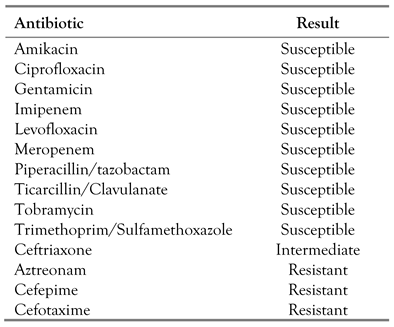Fatal Hemorrhagic Bronchopneumonia Caused by Bordetella bronchiseptica in an Immunocompetent Patient
Abstract
Introduction
Case report
Discussion
Conclusions
Author Contributions
Funding
Conflicts of Interest
Consent
Availability of Data
References
- Linz, B.; Ma, L.; Rivera, I.; et al. Genotypic and phenotypic adaptation of pathogens: Lesson from the genus Bordetella. Curr Opin Infect Dis. 2019, 32, 223–230. [Google Scholar] [CrossRef] [PubMed]
- Goodnow, R.A. Biology of Bordetella bronchiseptica. Microbiol Rev. 1980, 44, 722–738. [Google Scholar] [CrossRef] [PubMed]
- Woolfrey, B.F.; Moody, J.A. Human infections associated with Bordetella bronchiseptica. Clin Microbiol Rev. 1991, 4, 243–255. [Google Scholar] [CrossRef] [PubMed]
- Gujju, V.R.; Akram, B.; Shibib, D.R.; McGhee, M.A.; Drevets, D.A. Bordetella bronchiseptica infections in patients with HIV/AIDS: A case report and review of the literature. Medicine (Baltimore) 2021, 100, e28244. [Google Scholar] [CrossRef] [PubMed]
- Tamion, F.; Girault, C.; Chevron, V.; Pestel, M.; Bonmarchand, G. Bordetella bronchoseptica pneumonia with shock in an immunocompetent patient. Scand J Infect Dis. 1996, 28, 197–198. [Google Scholar] [CrossRef] [PubMed]
- Clements, J.; McGrath, C.; McAllister, C. Bordetella bronchiseptica pneumonia: Beware of the dog! BMJ Case Rep. 2018, 2018, bcr2018224588. [Google Scholar] [CrossRef]
- Guetter, S.D.; Eiteman, M.A. Production of biomass and filamentous hemagglutinin by Bordetella bronchiseptica. Bioprocess Biosyst Eng. 2014, 37, 115–123. [Google Scholar] [CrossRef] [PubMed]
- Endoh, M.; Nagai, M.; Ueda, T.; Yoshida, Y.; Nakase, Y. Cytopathic effect of heat-labile toxin of Bordetella parapertussis on aortic smooth muscle cells from pigs or guinea pigs. Microbiol Immunol. 1988, 32, 423–428. [Google Scholar] [CrossRef] [PubMed]
- Brockmeier, S.L.; Register, K.B.; Magyar, T.; Lax, A.J.; Pullinger, G.D.; Kunkle, R.A. Role of the dermonecrotic toxin of Bordetella bronchiseptica in the pathogenesis of respiratory disease in swine. Infect Immun. 2002, 70, 481–490. [Google Scholar] [CrossRef] [PubMed]
- Kurzynski, T.A.; Boehm, D.M.; Rott-Petri, J.A.; Schell, R.F.; Allison, P.E. Antimicrobial susceptibilities of Bordetella species isolated in a Multicenter Pertussis Surveillance Project. Antimicrob Agents Chemother. 1988, 32, 137–140. [Google Scholar] [CrossRef] [PubMed]

 |
© GERMS 2023.
Share and Cite
Tessier, S.; Longo, S.; Turki, M.; Numeir, M.; Le, T.; Ido, F. Fatal Hemorrhagic Bronchopneumonia Caused by Bordetella bronchiseptica in an Immunocompetent Patient. Germs 2023, 13, 172-176. https://doi.org/10.18683/germs.2023.1381
Tessier S, Longo S, Turki M, Numeir M, Le T, Ido F. Fatal Hemorrhagic Bronchopneumonia Caused by Bordetella bronchiseptica in an Immunocompetent Patient. Germs. 2023; 13(2):172-176. https://doi.org/10.18683/germs.2023.1381
Chicago/Turabian StyleTessier, Steven, Santo Longo, Mohamed Turki, Malek Numeir, Thong Le, and Firas Ido. 2023. "Fatal Hemorrhagic Bronchopneumonia Caused by Bordetella bronchiseptica in an Immunocompetent Patient" Germs 13, no. 2: 172-176. https://doi.org/10.18683/germs.2023.1381
APA StyleTessier, S., Longo, S., Turki, M., Numeir, M., Le, T., & Ido, F. (2023). Fatal Hemorrhagic Bronchopneumonia Caused by Bordetella bronchiseptica in an Immunocompetent Patient. Germs, 13(2), 172-176. https://doi.org/10.18683/germs.2023.1381




